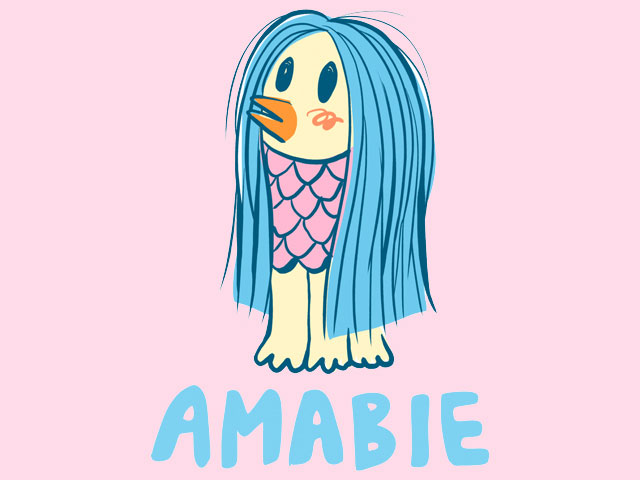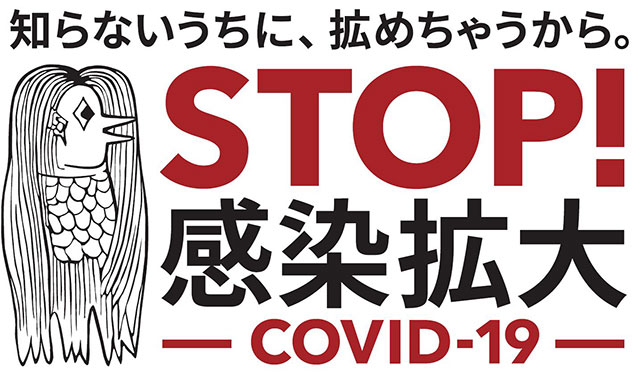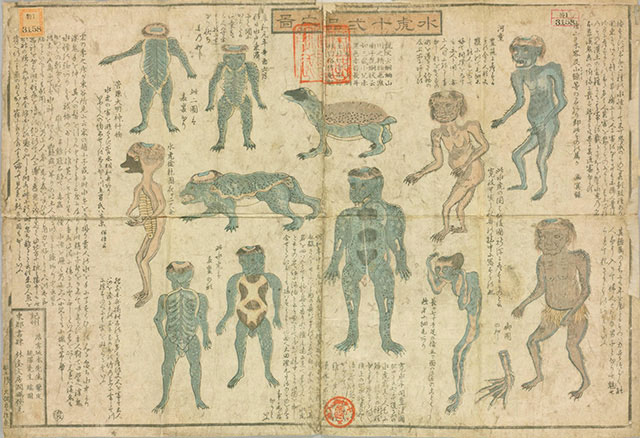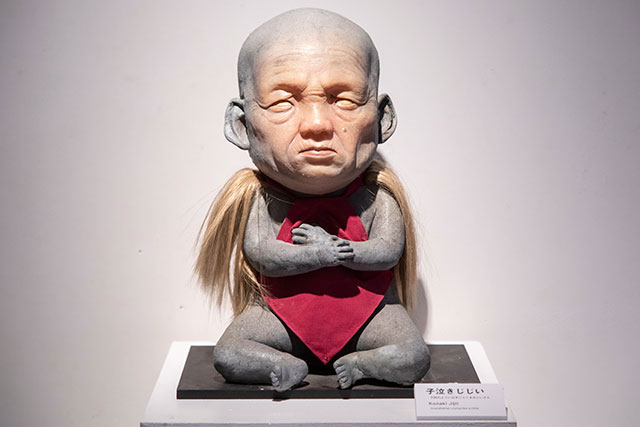
The hope of a swift end to the pandemic in Japan has taken the form of a yokai, a supernatural being which went viral on social media. Amabie and other mysterious monsters known as yokai were associated with folk narratives and were also known as part of local belief systems in villages and cities throughout Japan. But where do these yokai come from? Are they part of the traditional folklore of Japan, or are they recent creations?
-
01
Who is Amabie(アマビエ)?
Amabie, is a beaked fish person looking yokai, who was first documented in the Edo period on kawaraban, a one page woodblock print that had illustrations and newsy information including gossip. Its name is pronounced Ah-mah-bee-ey. According to the lore, the creature predicted the future to a passerby and appeared in the sea of Higo province, now known as Kumamoto prefecture on the island of Kyushu. Amerbie said “ Six years of good harvest are on the way. In the case of a plague, draw the illustration of me (Amabie) and show it to others to keep the disease at bay”. A sketch of Amabie was then printed, and as the kawaraban spread, so did the tales of this mysterious beaked fish person spread from the island of Kyushu all the way to Edo(current Tokyo).
![]()
Illustration of Amabie possibly drawn in mid April in 1846 from the date said, which is preserved at Kyoto University Library (京都大学貴重資料デジタル・アーカイブ)
-
02
What made Amabie go viral?
Kyoto University Library posted on its Twitter account a picture of the original illustrations of Amabie with its description on March 6th. According to the date written, the original one is said to be drawn somewhere mid April in 1846. This went viral on social media, and since then, many users have been drawing their own Amabie and have been re-posting or re-tweeting it, in hope for a swift end to the surge of COVID-19. Some researchers analyze this trend as not much different from the psychology of people in the Edo period. It makes sense, then, that it has resurfaced during the global COVID-19 pandemic, only this time on social media. Even the Ministry of Health, Labor and Welfare appointed Amabie as an awareness character for COVID-19 on April 13th 2020. In additions to the tens of thousands of paintings, drawings and personalised depictions of Amabie on Twitter and Instagram, Google Trends analyzed its popularity spreading across the continents with an English hashtag, #AMABIEchallenge. Now, people in Japan have begun selling products with Amabie’s images or even Amabie shaped snacks.
-
03
Who are these monsters known as yokai(妖怪)?
![Amabie distributed by the Ministry of Health, Labor and Welfare]()
Amabie distributed by the Ministry of Health, Labor and Welfare
Yokai(妖怪) are a strange and supernatural creatures first seen in illustrations in Japanese folklore, Hyaku-monogatari (Tales of Japanese Horror) during the Edo period, although its story has been noted in a much ancient written materials such as Kojiki (古事記,Record of Ancient Matters) and Nihon-Shoki(日本書紀,The Chronicles of Japan). Many different English words like monsters, spirits and demons, have been used as its translations, however, nothing exists in the English language that quite describes it. It is just one of the words that just works better in its native tongue. People in the Edo period believed in the existence of kappa, known at that time as Suiko (水虎) meaning water tiger. Out of the many technical books about Kappa, the most famous, “Suiko Kouryaku (水虎考略), Illustrated Guide to Kappa” was drawn by Koga Douan in 1820. Based on his guide, The “Suiko juni-hin no zu(水虎十弐品之圖),Illustrated Guide to 12 Types of Kappa” was later made by Kounen Sakamoto and his brother, Jyuntaku Sakamoto, who were both doctors in the 1800’s.
![Illustrated Guide to 12 Types of Kappa (水虎十弐品之圖) from National Diet Library, Tokyo, Japan.]()
Illustrated Guide to 12 Types of Kappa (水虎十弐品之圖) from National Diet Library, Tokyo, Japan.
In Japanese, these yokai are otherwise known as ayakashi (妖)and mononoke (物の怪). The three most famous examples of yokai are oni (鬼,ogre), kappa(河童,reptilian humanoids who inhabit the rivers and streams found all over Japan) and tengu (天狗,humanoid bird).
-
04
Why is there yokai?
![The three most famous yokai]()
The three most famous yokai
It is hard to find out why there are yokai in the first place. Some say that they are born from the fear like for instance, when you hear strange sounds at night, it is not difficult to imagine that some sort of creature or spirit is making them. Or, they are a sense of awe for animals and nature that humans can’t control. But other than being “folkloric”, some yokai might have appeared in printed texts. All of these different spheres of cultural production are so deeply intertwined and symbiotic, it is probably impossible to sort out which yokai is “folk” from the commercials. In anyhow, whether as incidents, supernatural entities or other reasons, these yokai existed and still its influence can be seen in all aspects of Japanese culture from films to games to manga to many more. Some say that a manga artist, Shigeru Mizuki rediscovered yokai’s charm and re-introduced them as his comic series, GeGeGe no Kitaro which caused a second explosion of interest in the supernatural beings up to today.
-
05
Recommended places to travel to learn more about yokai culture
The Yokai Art Museum on the Shodoshima Island which hosts artworks of yokai and is one of the largest museums in Japan depicted to present day yokai. The museum itself is located just fifteen minutes away on foot from Tonosho Port, the gateway to Shodoshima.
![Konaki-jiji, a yokai sculpture exhibited at the museum]()
Konaki-jiji, a yokai sculpture exhibited at the museum
- Yokai Art Museum
-
3.5
21 Reviews -
-
- Kagawa Shozu-gun Tonoshocho Ko 405
-
-
-
- 0879620221
-
-
-
- 9:00-22:00 (entrance informa…
-
View AllOne of the most famous manga artists, Shigeru Mizuki reintroduced the charm of yokai and made it popular till now through his manga, GeGeGe no Kitaro. Though Shigeru passed away in 2015, his legacy still lives on through his creations seen all over his hometown in Sakaiminato in Tottori prefecuture. His Mizuki Shigeru Museum is just about 10 minutes walk from the nearest station, JR Sakai-minato station and hosts many of his works.
![The main character, Kitaro from GeGeGe no Kitaro]()
The main character, Kitaro from GeGeGe no Kitaro
- Mizuki Shigeru Memorial Museum
-
4.0
312 Reviews -
-
- Tottori Pref. Sakaiminatoshi Honmachi 5
-
-
-
- 0859422171
-
-
-
- 9:30-17:00 (Admission until …
-
View AllMiyoshi Mononoke Museum is the first museum dedicated to Japanese folklore monsters which opened near Hiroshima in 2019. Formally known as Yumoto Koichi Memorial Japan Yokai Museum, the museum hosts about 160 items from Yumoto’s collection, which includes a scroll painting of the famous folktale and crafts. Interactive digital installations of yokai are available by teamLab, a team of special artists renowned for its digital art exhibitions. From the closest station, Miyoshi Station, it's about 30 minutes walk so it's best advised to book a taxi for those who don't want to walk that long.
![Digital book of yokai by teamLab]()
Digital book of yokai by teamLab
There are many other places that has connections with yokai, like Negoroji-Temple which is said to preserve the horns of a legendary bull headed winged ogre, Gyuki/Ushioni (牛鬼) who was said to eat humans and were very harmful. Kurama-Dera temple which is said to be the headquarter for tengu. And also Kappabashi Street, an area of downtown Tokyo near Asakusa renowned for its kitchenware stores and its plastic models of food that make handy souvenirs. For those fans of all things scary, creepy, mythic, and monster, this might be a new way to travel Japan and to see its unique culture.
- Negoro-ji Temple
-
4.5
50 Reviews -
-
- Kagawa Pref. Takamatsushi Nakayamachou 1506
-
-
-
- 0878813329
-
-
-
- 7:00-17:00
-
View All- Kurama-dera Temple
-
4.5
402 Reviews -
-
- Kyoto Kyoutoshi Sakyou-ku Kuramahonchou 1074
-
-
-
- 0757412003
-
-
-
- [Opening hours for worship]9…
-
View All- Kappabashi Dougu Street (R)
-
4.0
1310 Reviews -
-
- Tokyo Taitou-ku Nishiasakusa 1
-
-
-
- 0338441225
-
-
-
- Depends on establishment
-
View All






 Go here
Go here












